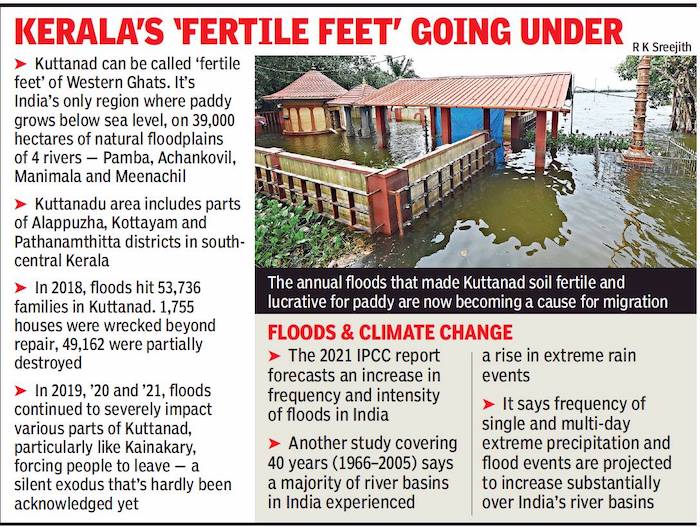Kuttanad
This is a collection of articles archived for the excellence of their content. Additional information may please be sent as messages to the Facebook community, Indpaedia.com. All information used will be gratefully acknowledged in your name.
This is a collection of articles archived for the excellence of their content. |
Floods and the rice bowl
As in 2021
Jaikrishnan Nair, Nov 17, 2021: The Times of India

From: Jaikrishnan Nair, Nov 17, 2021: The Times of India
Flooding has been an integral part of life in Kuttanad. The seasonal disruption it inflicts is more than made up for by mineralrich silt it leaves behind in this “rice bowl” of Kerala. But over the last decade, and more conspicuously since 2018, flooding has become regular and, worse, the water doesn’t drain.
Experts attribute the flooding to unseasonal rains and to the lowland sinking further — the first a consequence of deforestation in the Western Ghats, and the latter, a result of rising sea levels. The sea-level rise is fractional but in Kuttanad, the only place in India of substantial size where rice is grown close to 10 feet below sea level, it might prove catastrophic.
Hundreds of farming families, rooted to this place for generations, are abandoning ancestral hearths to move to other farmlands or to towns.
Kerala officials reluctant to talk about ‘exodus’
The “exodus” is still largely invisible, especially to government and official agencies.
“After the 1924 floods, there was an influx into Kuttanad as soil had turned fertile. But after 2018 floods, people are moving out… The rise in sea level is very minute but if the flooding of rivers is followed by tidal floods, it will be very dangerous,” says KG Padmakumar, director of International Research and Training Centre for Below Sea Level Farming.
In Kainakary in Alappuzha, where it is taking longer and longer for the waters to recede after each flood, the options for farmers have been shrinking by the year. P Rajkumar owned 2 acres of paddy fields and till 2018, life was comfortable for his family that includes his wife, minor son and mother. All that changed after the deluge in August that year.
“There was water in our house for days. No electricity, no cellphone reception and we were scared to go out. We couldn’t sleep at night as there was no one else in the neighbourhood,” he says. “Drinking water increasingly became hard to obtain. Nowadays, we face floods through the year,” his wife said. The family has bought 3.5 cents of land in Gurupuram, a locality relatively safe from floods, and built a house.
There are around 5,000 families in Kainakary panchayat comprising 15 wards. The exodus of locals is not yet part of any government study and officials are reluctant to discuss the issue. “There is no provision for the water to flow out of Kainakary. The number of canals has come down and the existing ones have narrowed and easily spill over,” said Jayan Chambakkulam of Integrated Rural Technology Centre.